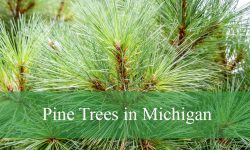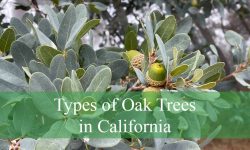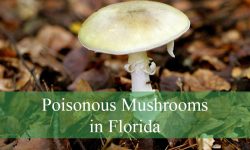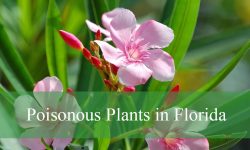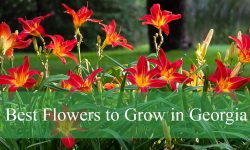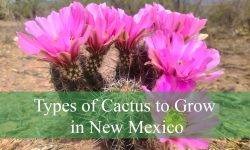Choosing colors in the vivid pallet of garden design is an art, with certain shades being more uncommon than others. Among the typical blooms of red, yellow, and pink, my personal favorite is the mysterious blue. I am ecstatic to have found blue wildflowers and added them to my yard; they make my place a peaceful, serene haven of beauty.
Come along and discover the magical world of blue wildflowers, where every tiny bloom adds a distinct shade to make an eye-catching rainbow of colors.
Different Types of Blue Wildflowers
Mountain Bluebells
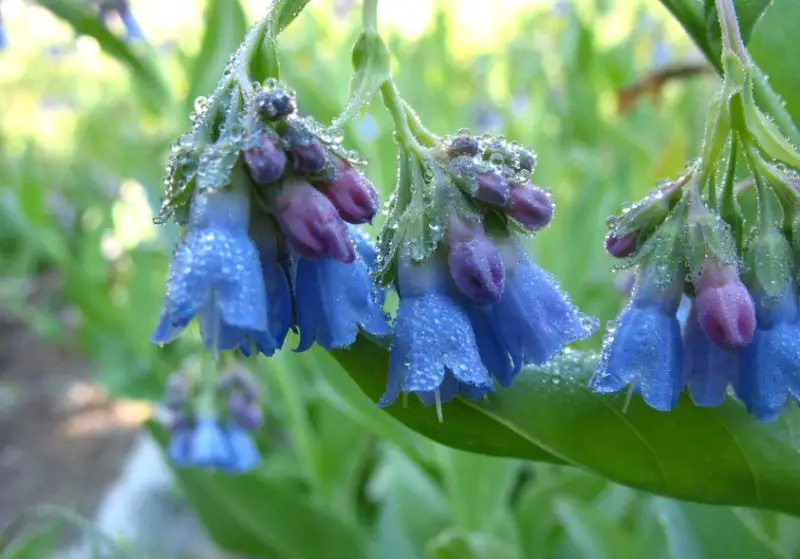
Mountennium Bluebells (Mertensia ciliata), so named because of their mountainous environment, grow to a height of 48 inches in moist, sunny soil at high altitudes. They readily adapt to gardens by proliferating through seeds and exhibiting disease resistance. During the hottest summer days, their blue blossoms open. They are found all over the country, although they are most common in the Southwest. Because of their striking resemblance, Mountain Bluebells, which belong to the Bluebells group, are often confused with Prairie Bluebells.
Broadleaf Lupine
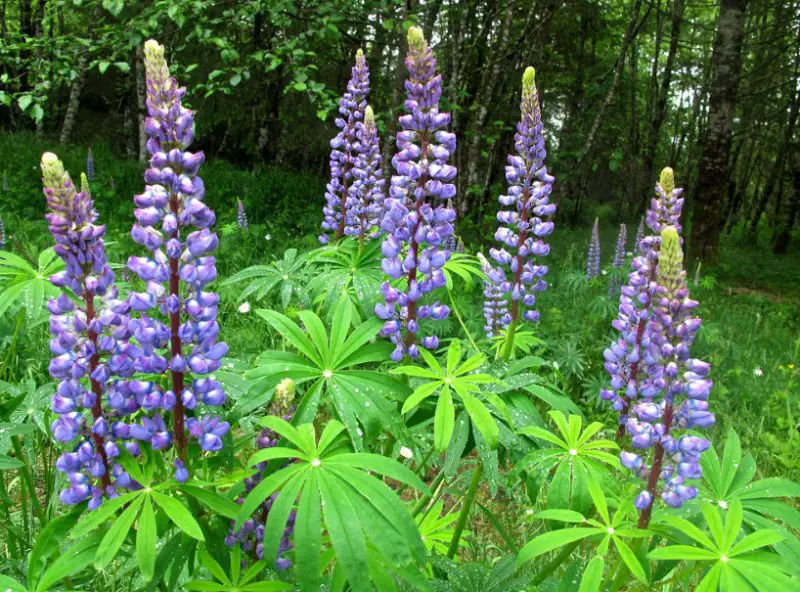
Broadleaf lupines (Lupinus latifolius), which are common on the West Coast, are good for ecosystems. They are useful for stabilizing soil and providing ground cover because of their deep, spreading roots. Their long, blue-hued inflorescences draw a lot of pollinators, and they grow well on high elevation grasslands with full sun. It is not advisable to put them in gardens as they may cause poisoning in animals who eat them.
Columbian Monkshood
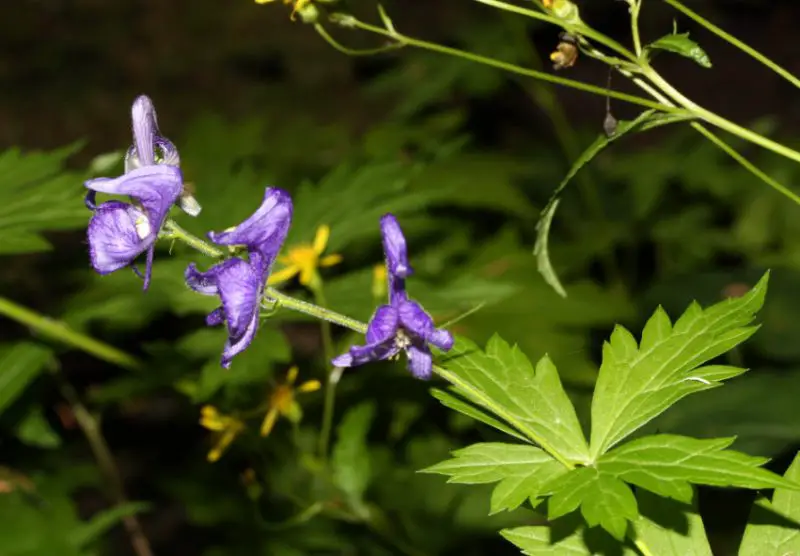
The Columbian Monkshood (Aconitum columbianum), unique to eastern North America, grows at medium to high elevations in the West Coast and Rockies. Each stalk displays up to three tiny blue flowers with a faint purple nuance. Although blue is the usual color, uncommon varieties of Columbian Monkshood also have white flowers.
Blue Curls
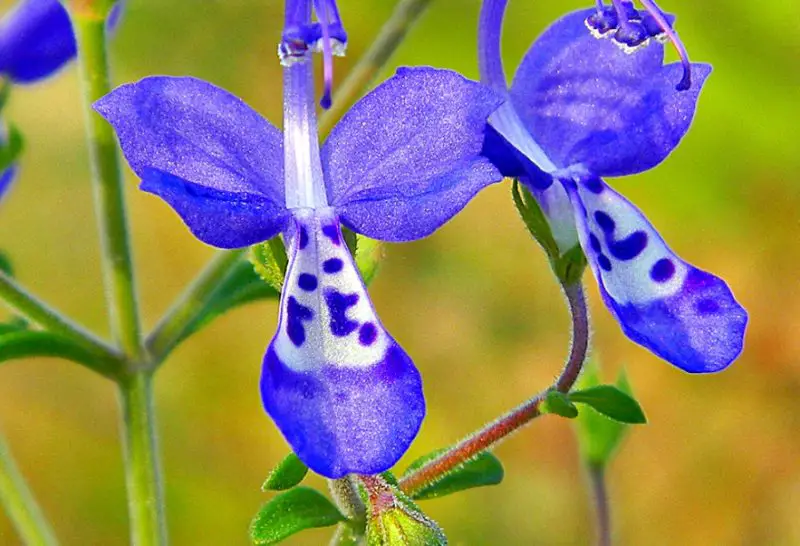
Blue Curls (Trichostema dichotomum), which are distinguished by blue petals and stamens that can range in color from blue to purple, are commonly found in sandhill habitats in the Southeast United States as well as at higher altitudes in pine forests. These wildflowers, which resemble mint plants, are named for their curled stamens. They are members of the mint family. They grow well in full sun and can be grown in gardens. As summer comes to an end and the temperature starts to drop, blue curls sprout.
Borage
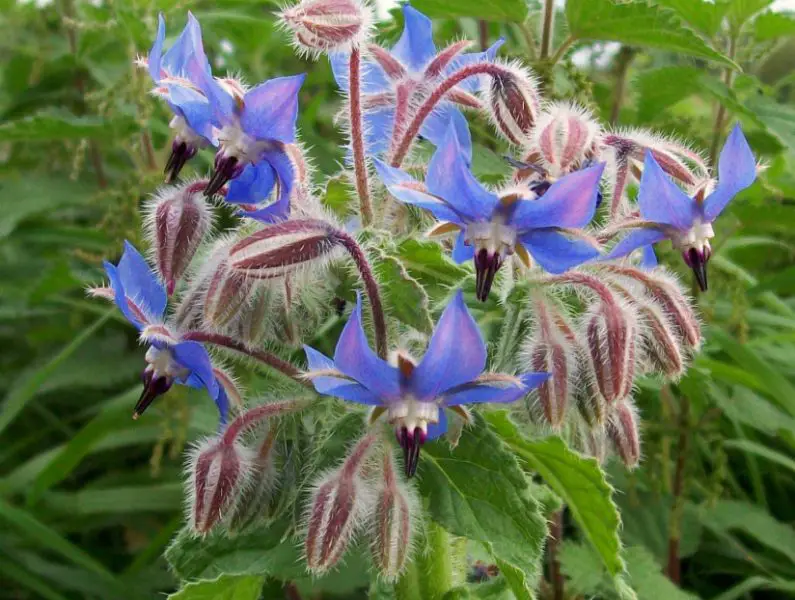
Native to Europe and introduced worldwide, Borage (Borago officinalis) is a blooming plant found in nurseries and gardens that has little blue flowers. All components, including the blue foliage, are tasty and well-known for it. Cooking uses the plant’s derived borage oil. It was originally a common addition to drinks, like mint leaves, adding flavor as well as decoration. This blue wildflower can grow to a height between 2 and 3 feet.
Closed Bottle Gentian
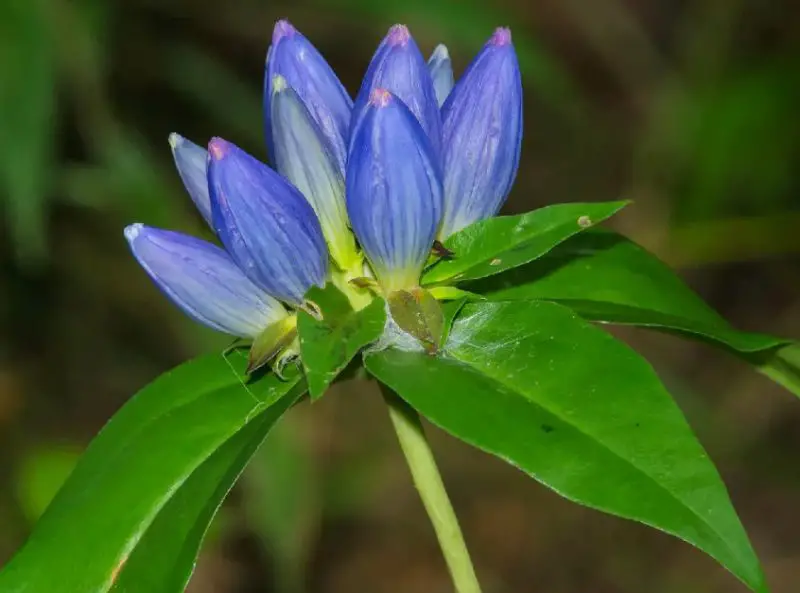
The distinctive upturned blue flowers of the Closed Bottle Gentian (Gentiana andrewsii), which is native to the East Coast, are closed during the day and are only accessible to hardy bees for pollen. It opens its closed blooms in August and keeps them open until October, blooming later in the summer and fall. Six to eight flowers in tiny groupings adorn each stalk.
Oceanblue Morning Glory
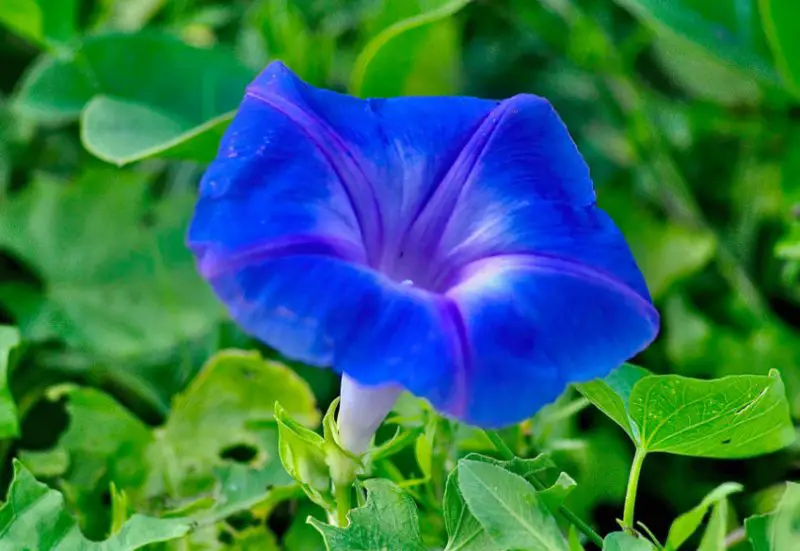
Ipomoea indica, commonly known as Oceanblue Morning Glory, is a rare wildflower that varies in color throughout the day. The flowers are blue at first, but they become dark blue in the afternoon, lavender at dusk, and blue again the next day. These trailing flowers, which are frequently grown in gardens and cities, are invasive because they spread quickly from seed and outgrow other plants and trees. They are indigenous to warm tropical regions where they display their unique color-changing show.
Grape Hyacinth
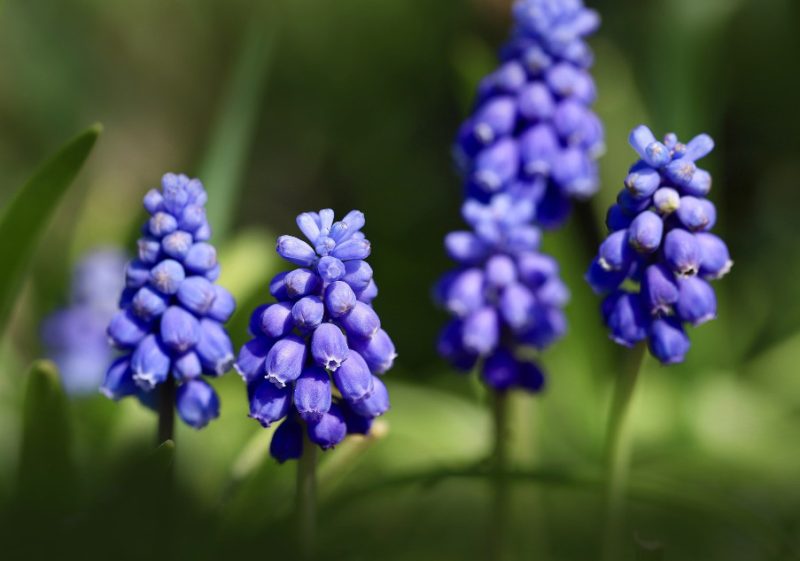
The perennial plant known as grape hyacinth (Muscari neglectum) is native to Europe and Asia and gets its name from its resemblance to grapes. It is a worldwide species that features solitary flower stalks with tiny, serrated blooms that are blue or blue-purple in color. But like Ocean Blue Morning Glory, Grape Hyacinth may also be invasive, growing quickly and creating monocultures that reduce ecosystems’ natural biodiversity.
Small-Flowered Blue-Eyed Mary
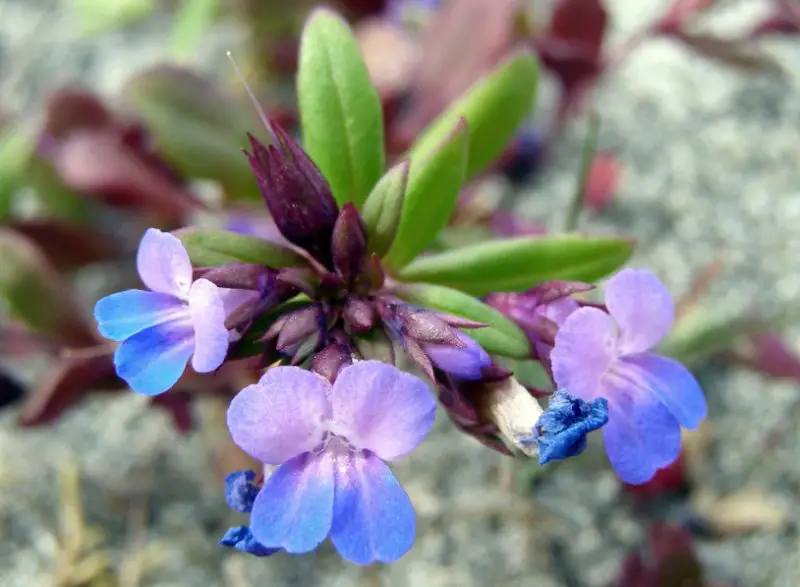
The smallest blue flowers are what give the Small-flowered Blue-eyed Mary (Collinsia parviflora) their name. The lowest portions of these little blossoms are partially blue in hue, while the higher portions are white. The stems are dotted with few, slender, elongated, green leaves that curve downward. This species is exclusive to forests; it lives in shady places in woodlands west of the Rocky Mountains and thrives at high elevations.
Climbing Dayflower
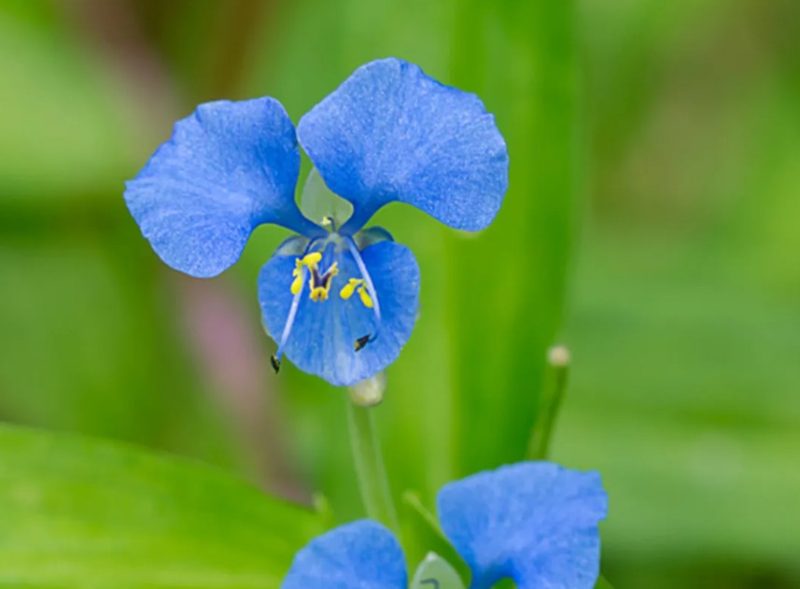
The Climbing Dayflower (Commelina diffusa), which is widely distributed from North America to Asia, has big blue blossoms that are somewhat edible. It is a frequent source of pollen for bees and is used to make handcrafted blue dye due to its vivid blue color. It was brought to North America from the West Indies and quickly spreads throughout Florida on disturbed soil. In the Southern states, the Climbing Dayflower has an extended flowering season.
Wood Forget-Me-Not
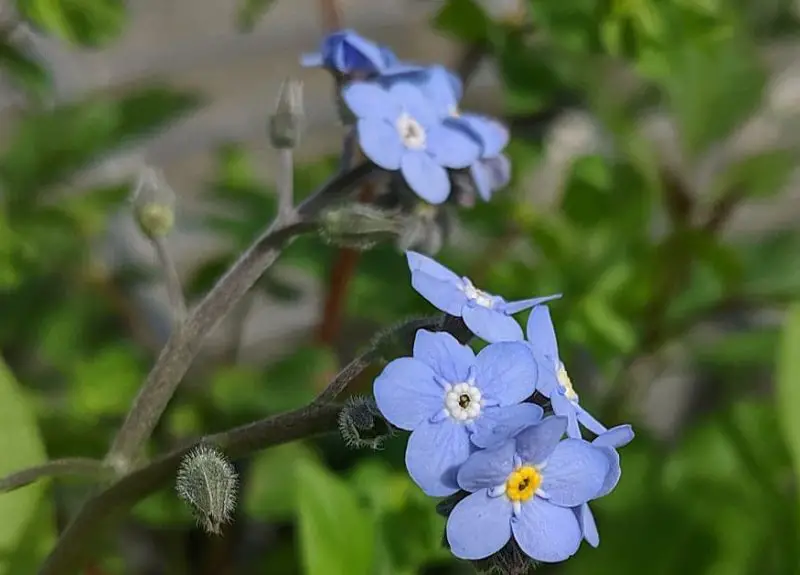
Small blue florets are the distinguishing feature of the short-lived Wood Forget-Me-Not (Myosotis sylvatica). It self-seeds and grows well in wet soils, with plants appearing the following year. Even though it is often little in stature, proper irrigation can cause it to grow to astonishing heights of up to 50 inches. It is frequently grown for its early blooms in gardens and urban locations. Although its flowers are fleeting, the leaves continue to grow into the winter, guaranteeing continuous visibility.
Chicory
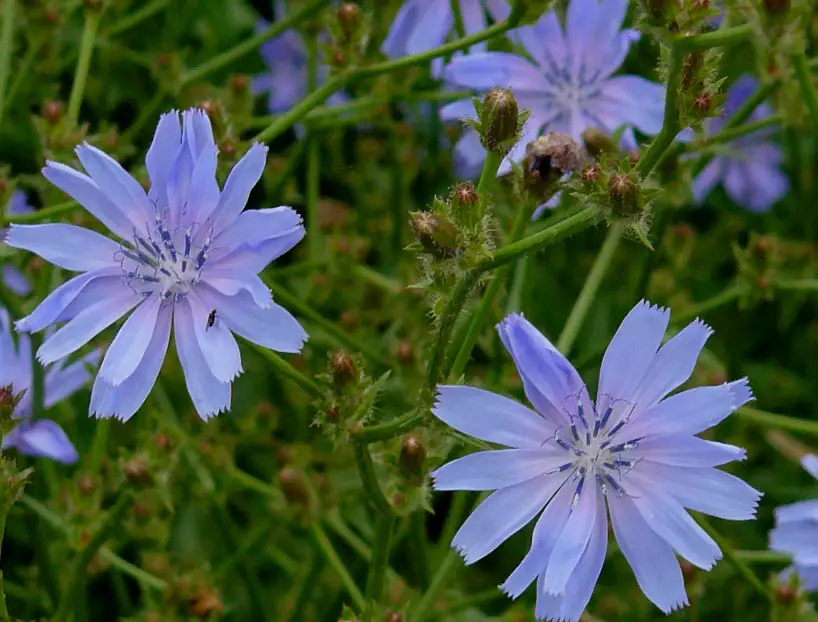
The chicory plant (Cichorium intybus), a member of the wide aster family, has beautiful blue flowers in a range of colors. These colors, which range from vivid blue to purple, set the species apart. It’s commonly called blue chicory, blue daisy, or blue weed, depending on the region in which it grows. The wildflower, which was brought to North America by European settlers, goes by several names here. Besides, chicory is completely edible and can be used in place of coffee. When eaten as food, it offers a combination of vitamins and calcium, adding to its nutritional benefits.
Virginia Bluebells
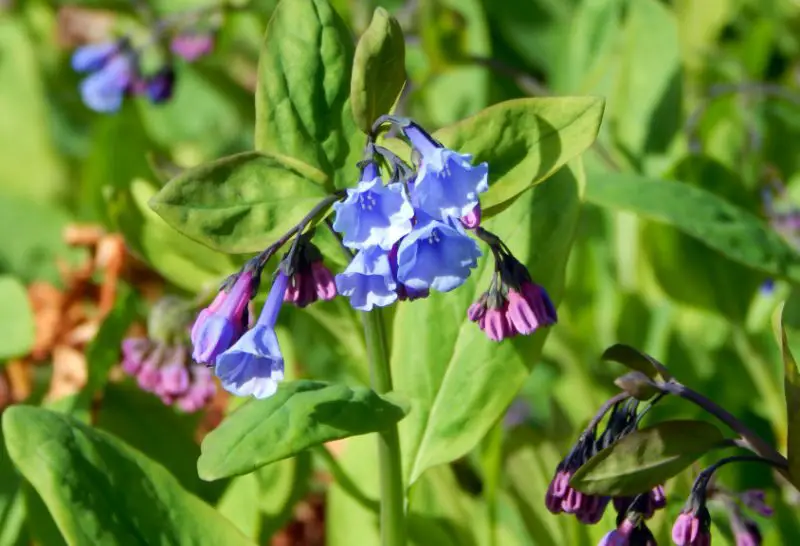
The common wildflower known as Virginia Bluebells (Mertensia virginica) is distinguished by its mostly blue blooms, which can also occasionally display pink tones or a combination of both. It is native to North America and grows widely throughout the Eastern Hemisphere. Long, dark green leaves that are larger than the blooms on the plant delicately surround the blossom. The petals of the plant can reach up to 5 inches in length. This species is used in traditional medicine despite its smaller stature, especially for treating common cold symptoms.
Bird’s-Eye Speedwell
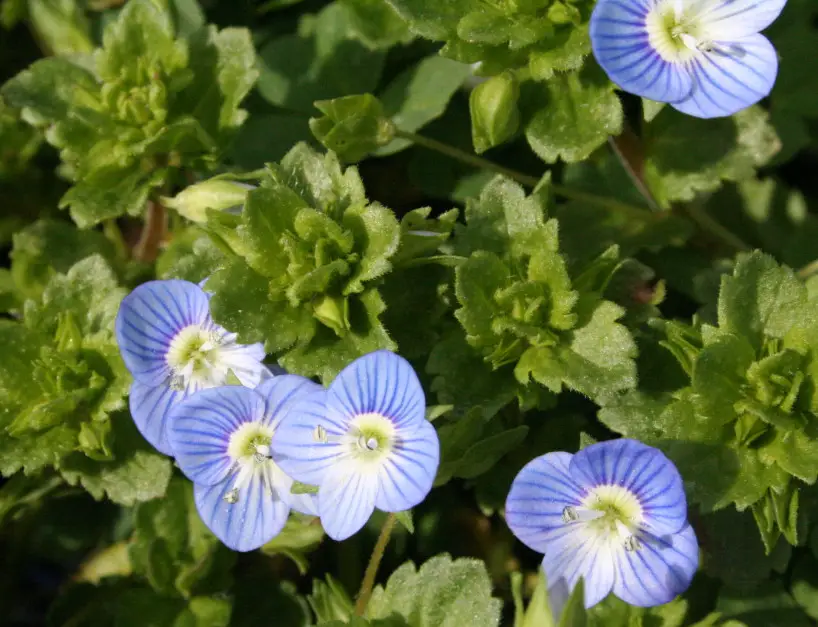
The Aerial View The small blue wildflower known as speedwell (Veronica persica) grows well in small spaces and can even tolerate lawn mowing. Though categorized as a weed, it frequently overgrows gardens and lawns, gaining the distinction of being an agricultural weed. It’s rarely grown in gardens or nurseries, despite its pretty little blue flowers. Its vivid blue flowers have contrasting dark blue stripes, and its dark green leaves set it apart.
Asiatic Dayflower
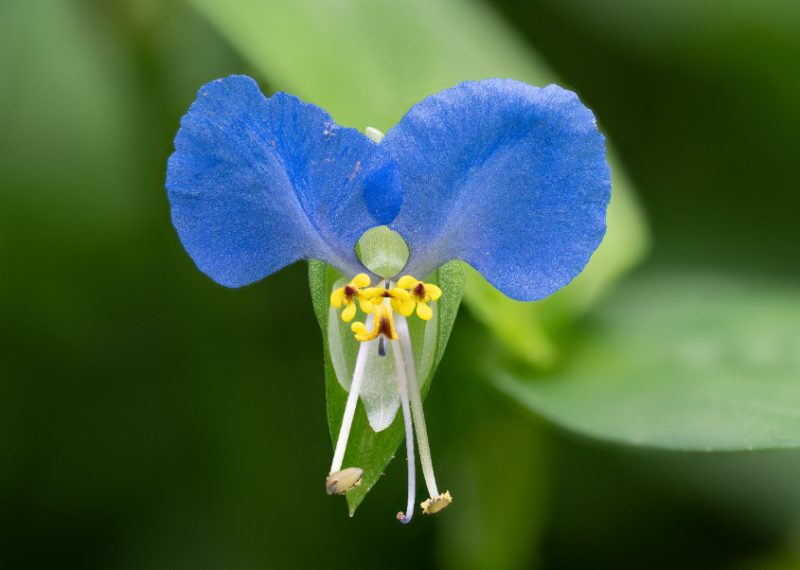
Because of its bilateral symmetry, the Asiatic Dayflower (Commelina communis) is distinct from other common blue species. Remarkable for having a lower white petal beneath the intricately patterned blue bloom, frequently with purple hints, the flower’s attractive contrast is enhanced by the opposing hues. Roadsides are frequent locations for this plant, which spreads quickly and grows well in disturbed land. It has yellow stamens.
Texas Bluebonnet
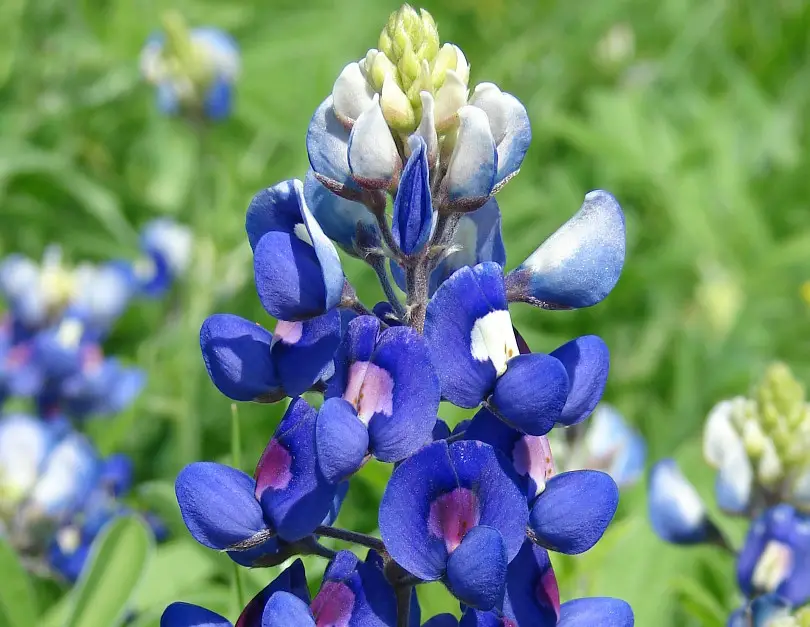
Being the state flower of the Lone Star State, the Texas Bluebonnet (Lupinus texensis) is known for its abundance of little blue blossoms. Popular and lovely, it grows well in the arid plains of the South but is especially happy in wet soil. High altitude tolerant, it can display hues other than the typical blue, such as variations in white and pink, especially in isolated locations. The plant ranges in height from 10 to 20 inches, however it can grow taller.
Whitemouth Dayflower
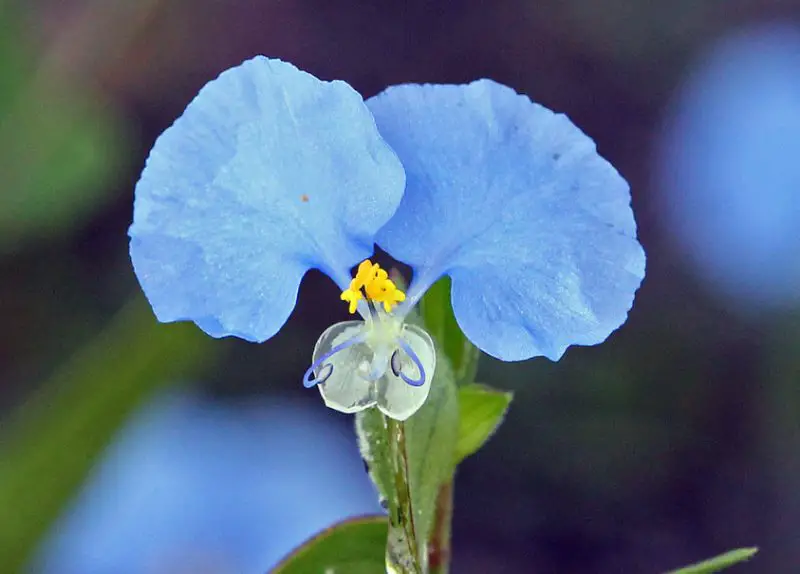
Large petals and a brilliant white pistil topped with a vivid yellow stigma define the unusual light blue flowers of the Whitemouth Dayflower (Commelina erecta). Long, broad green leaves complete it, making it a good attractive plant for gardens or container plants in nurseries. This species naturally spreads and establishes itself, flourishing in disturbed lands.
Pacific Hound’s Tongue
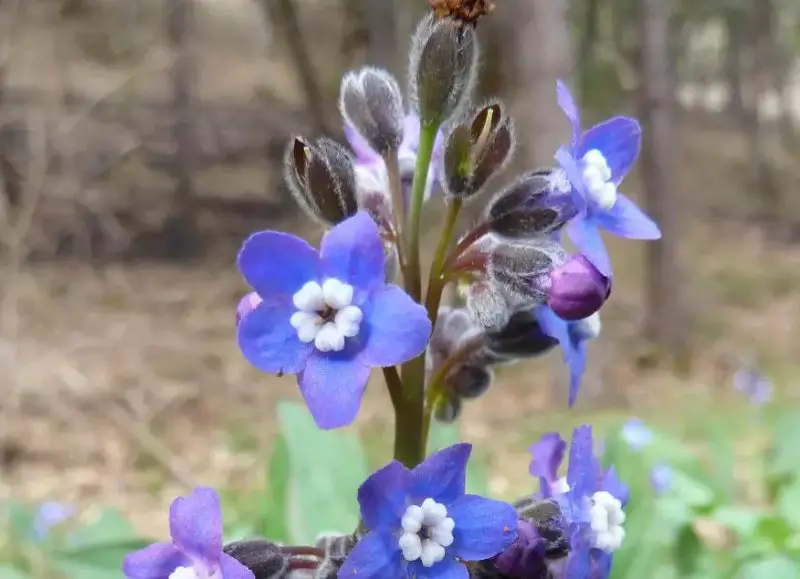
Many blue flowers adorn the Pacific Hound’s Tongue (Adelinia grande), a wildflower with a colorful past. The flowers are blue, from light to dark. The plant was traditionally used in teas to ease upset stomachs. Growing in a variety of conditions, it endures in high altitudes with little precipitation. Found mostly throughout California’s chaparral, it is also found along Canada’s and the United States’ west coasts. This hardy species is found in oak woodlands and grows well in dark areas, demonstrating its adaptability and vast distribution.
Chia
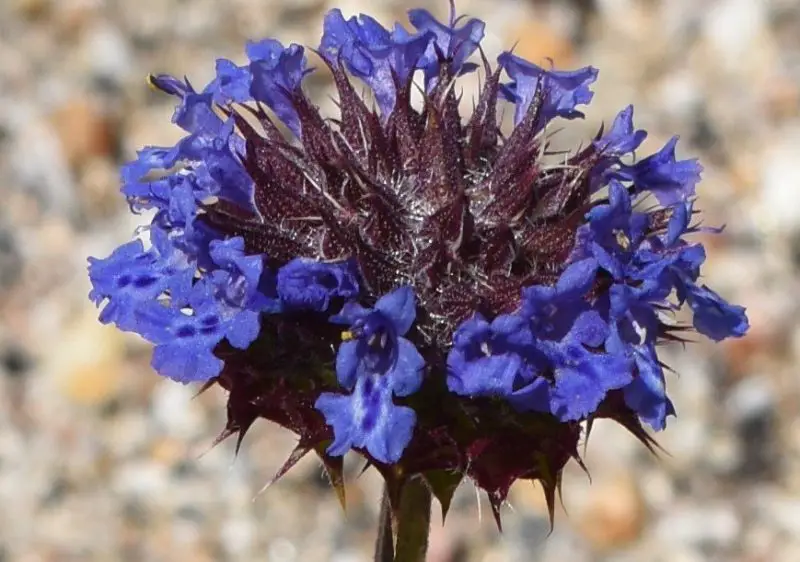
The distinctive blue-to-purple hues of the clusters of blue florets that range in color from light to dark blue make the Chia (Salvia columbariae) stand out. Thriving in California’s chaparral and coastal regions north to British Columbia, Chia is flexible, found at low and medium elevations, with sightings at altitudes exceeding around 8,000 feet. It can grow up to 19 inches tall and shows that it is adaptable because it can thrive in both clay and sandy soil.
Menzies’ Baby Blue Eyes
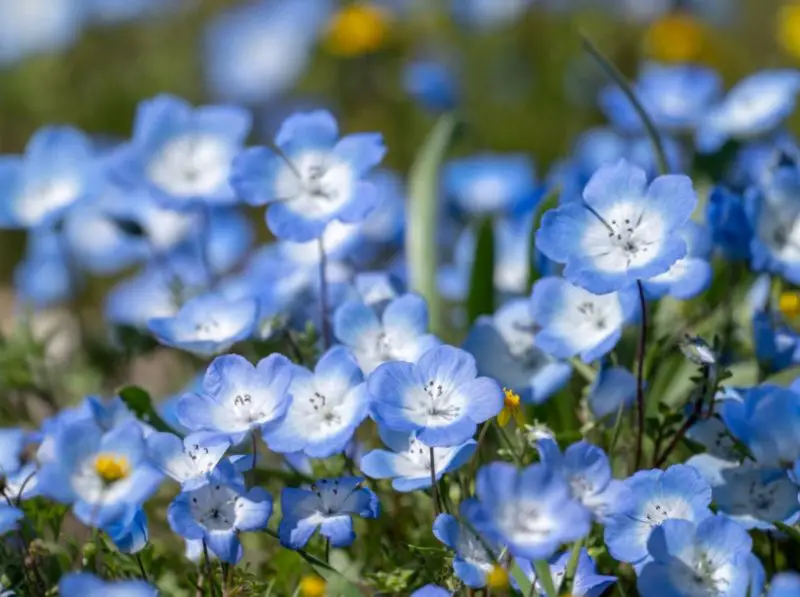
Nemophila menziesii, sometimes known as Menzies’ Baby Blue Eyes, are native to the Southeast and California, though they have also been imported to Utah and Alaska. Even at 6,000 feet in elevation, this wildflower, with its compact stature of 6 to 8 inches and vibrant blue flowers that occasionally blossom white, adapts well to California’s varied terrains. It’s interesting to note that Menzies’ Baby Blue Eyes do not display invasive tendencies when planted outside of their natural region, which makes them appropriate for garden cultivation in a variety of blue flower kinds.
Lewis Flax
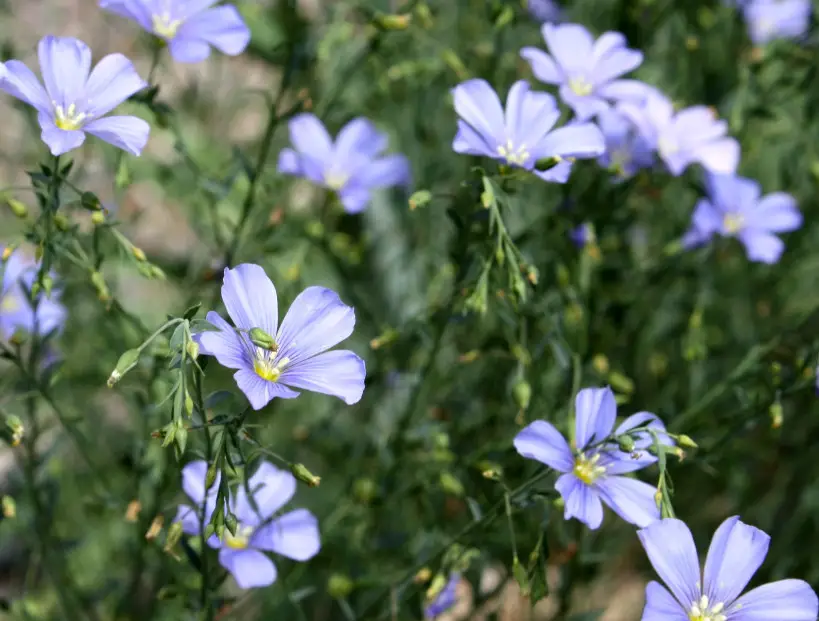
The herbaceous Lewis Flax (Linum lewisii), a native of North America, has several tiny blue flowers that draw insects. Frequently seen as a weed, especially on lawns, it spreads quickly through seeds, making hand picking necessary, especially on smaller surfaces. Lewis Flax is a vigorous plant that can outcompete other flowers for the garden. Its hardiness is demonstrated at high altitudes; in the Southeast, it thrives at elevations above 10,000 feet.
Cornflower
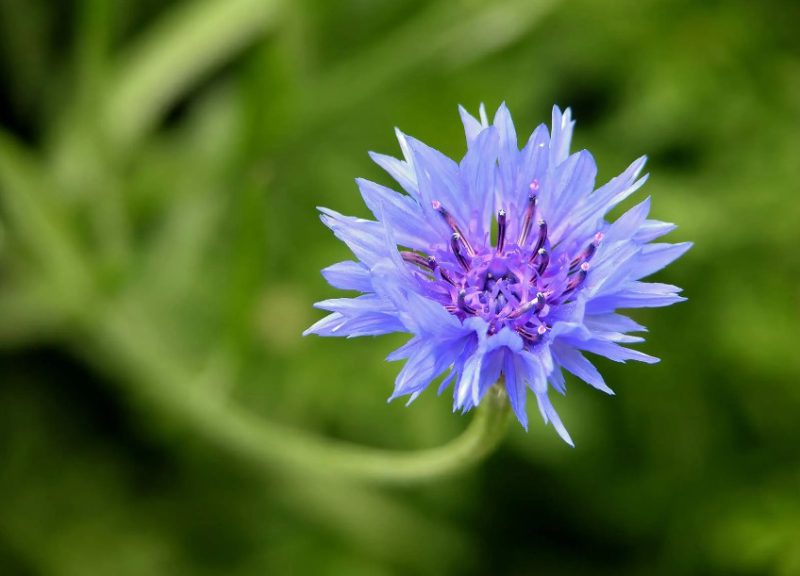
Cornflowers (Centaurea cyanus) are a plant that grows well in many temperate zones in North America and Europe. They have bright blue flowerheads. Because of restrictions on pesticides at lower elevations, more of these flowers can be found in higher elevations. Cornflowers are great for gardens and pots, but when grown indoors, they can get infections, especially root fungus, which is commonly caused by problems with acidic soil or over watering.
Siberian Squill
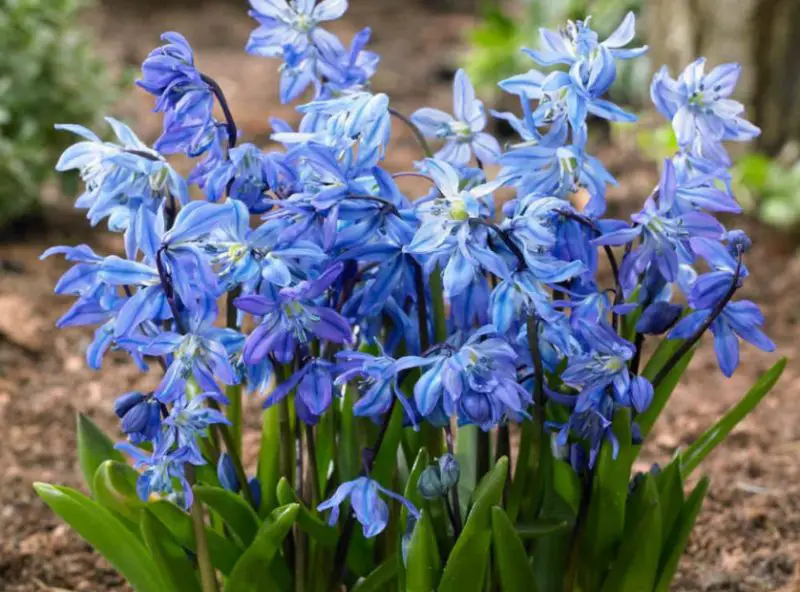
Originating in Asia, the Siberian Squill (Scilla siberica) has made a name for itself in North America with its huge blue blossoms that occasionally turn white. It grows quickly and spreads over large regions, but it only lives a short time in temperate grasslands. The wildflower, which can be identified by its curved blue petals, opens fully in direct sunlight. It’s interesting to note that it can withstand grass mowing, grows back from bulbs, and spreads efficiently via seed capsules. Notably, in the US, Siberian squill exhibits invasive behaviors.
Broadleaf Forget-Me-Not
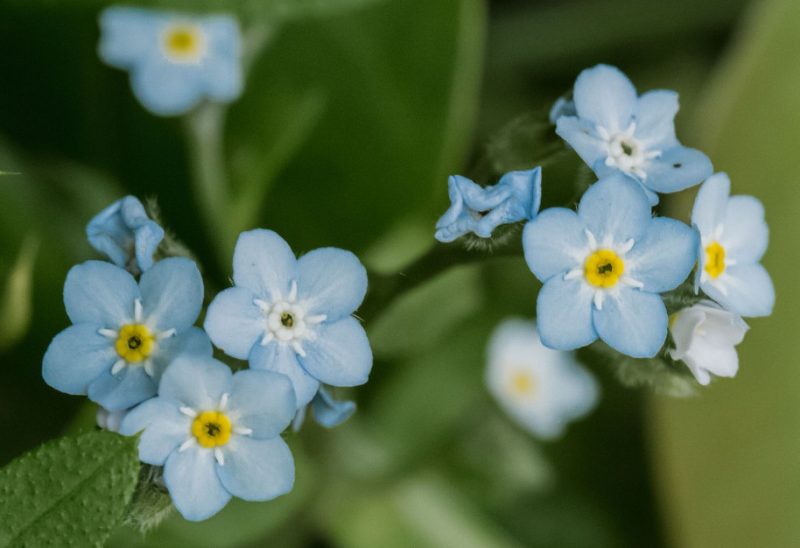
The Broadleaf Forget-Me-Not (Myosotis latifolia), a tall plant among wildflowers in North America, is well-known for its vivid colors and adaptability. It grows well in damp soils near water and can be found in both sunny and shaded regions. Its vivid blue petals enhance its aesthetic appeal when they open in warm weather. When placed in the proper area, this hardy herb can survive for several years at least.
Miniature Lupine
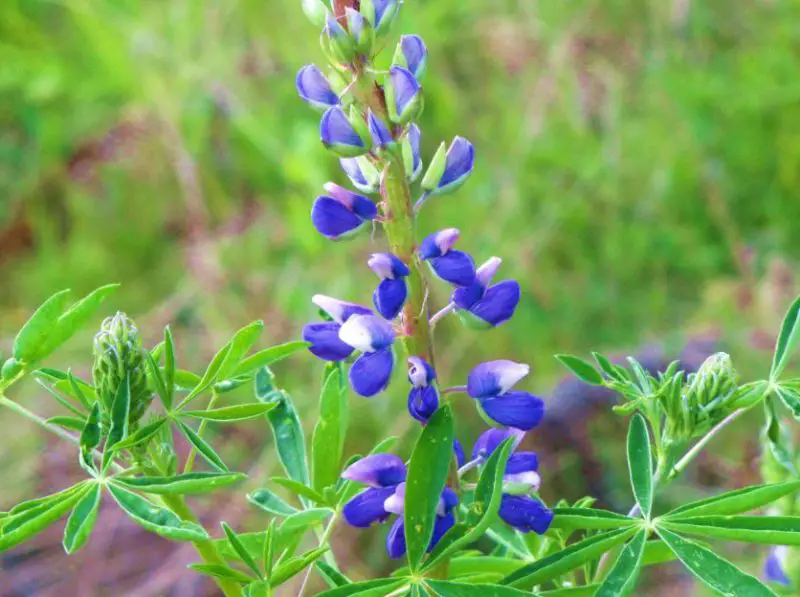
With a maximum height of about 3 inches and many being even shorter, miniature lupines (Lupinus bicolor) are notable for being among the smallest blue lupines. The species is adorned with blue flowers that come in different colors. These lupines are great for gardens since they are non-invasive and have thin, hairy, elongated leaves that are safe to touch. Common California pollinators are drawn to their modest, colorful profile because it is rich in pollen, which not only adds a brilliant touch to the garden but also supports local wildlife.
Distant Phacelia
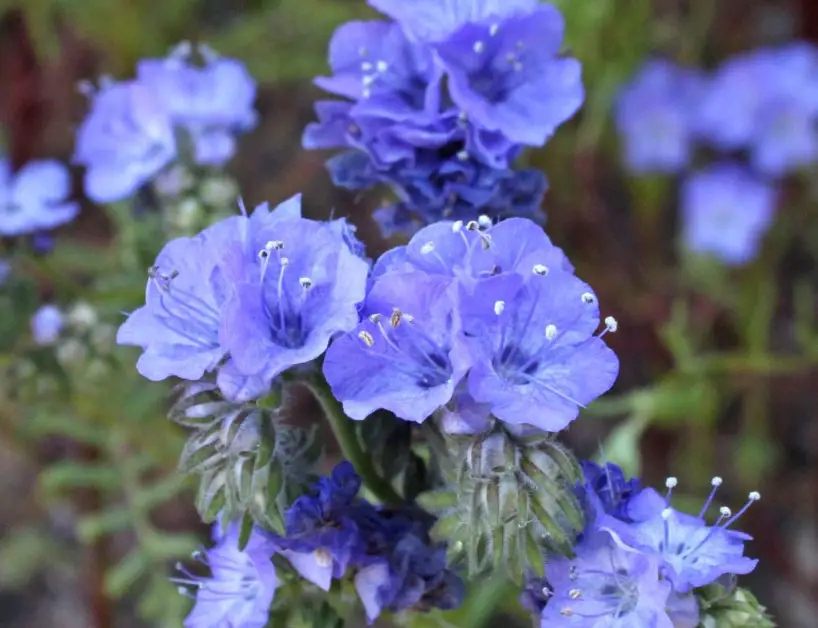
The Distant Phacelia (Phacelia distans) grows quickly and can reach an amazing height of up to 40 inches. It is ornamented with small, vibrant blue or blue-purple blooms and rare leaves. It is native to California and the coast of the West Indies, where it grows well in the chaparral and forests of the Southwest. Although it can grow in open grasslands, this tall wildflower prefers wooded settings or areas with tall grass, demonstrating its adaptability to a variety of environments.
Upland Larkspur
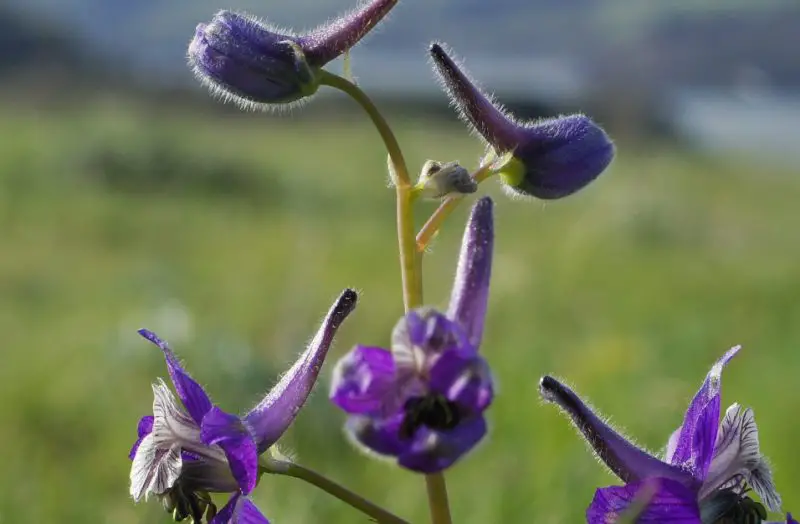
Upland Larkspur (Delphinium nuttallianum) is a species that grows well in meadows and arid areas. It has columnar growth and many little blue blooms. It is native to the southern and southwestern parts of the United States and is toxic, therefore cultivation should be avoided. The wildflower gets its name from its native habitat, which is mountainous locations with short vegetation. It is mostly poisonous when taken in high quantities by cattle.
Prairie Pleatleaf
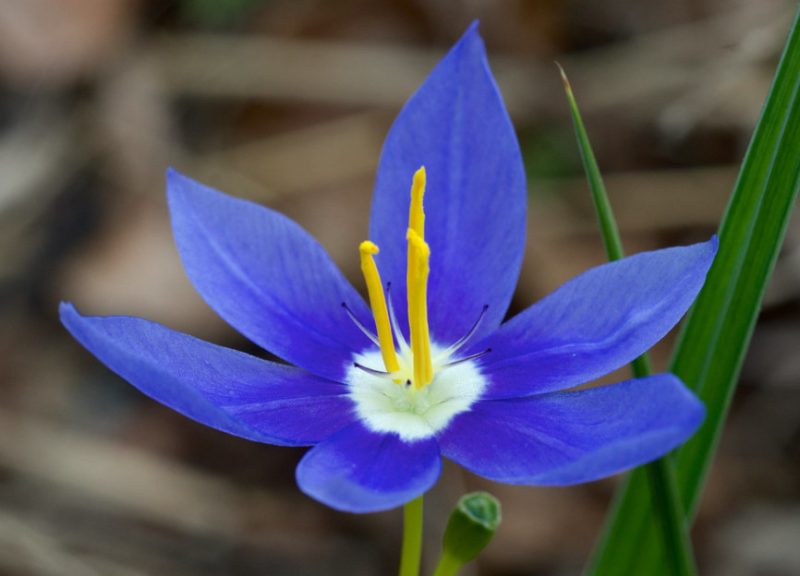
The Prairie Pleatleaf (Nemastylis geminiflora), which is native to states like Oklahoma and Texas, is restricted to higher elevations and prefers rocky slopes and hilly soils in grasslands. Growing to a height of 12 inches, the plant bears some of the largest blue flowers among prairie wildflowers, with a diameter of just less than 3 inches.
Royal Penstemon
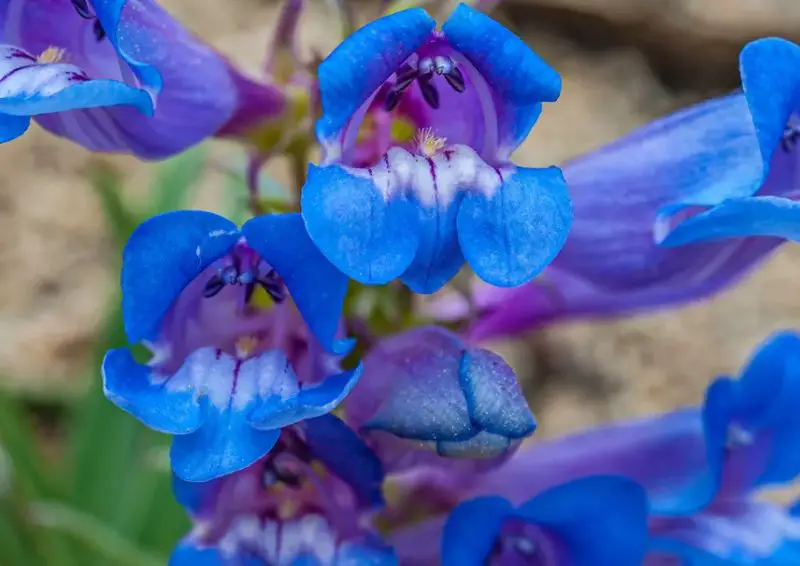
Penstemon speciosus, sometimes known as the Royal Penstemon, is a prairie-dwelling plant that produces 1.5-inch-long, deep blue blooms. It grows to a height of three feet, likes full sun, and is good for gardens, drawing wasps and bees. When grown successfully at home, it spreads quickly through soils that drain well and frequently starts from seeds.
Wartleaf Ceanothus
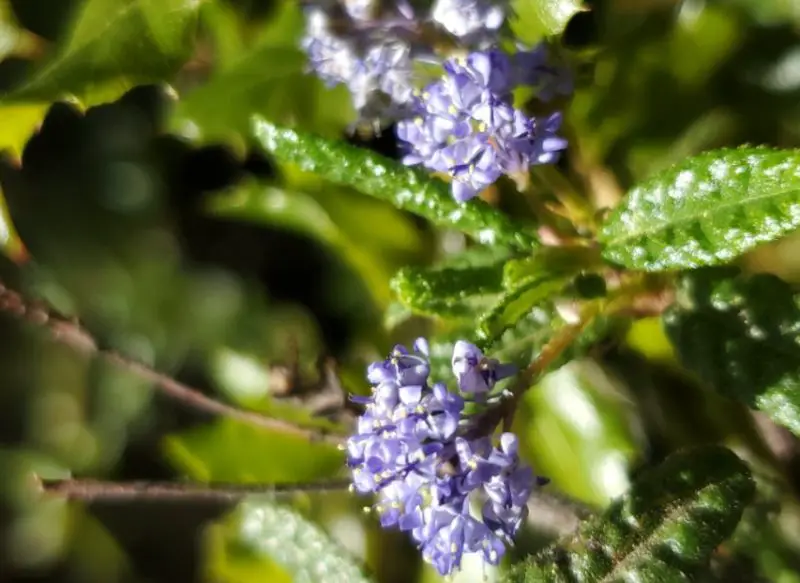
Found only in the chaparral of California, the Wartleaf Ceanothus (Ceanothus papillosus) is one of the rarest blue wildflowers in North America. Rising to a height of several feet, it can be found in a variety of forms, such as a shrub, tree, or wildflower. There are many small blue blooms on its inflorescence, but they only bloom for a short time. The leaves of the wildflower have a dark green color and include spines.
Parry’s Gentian
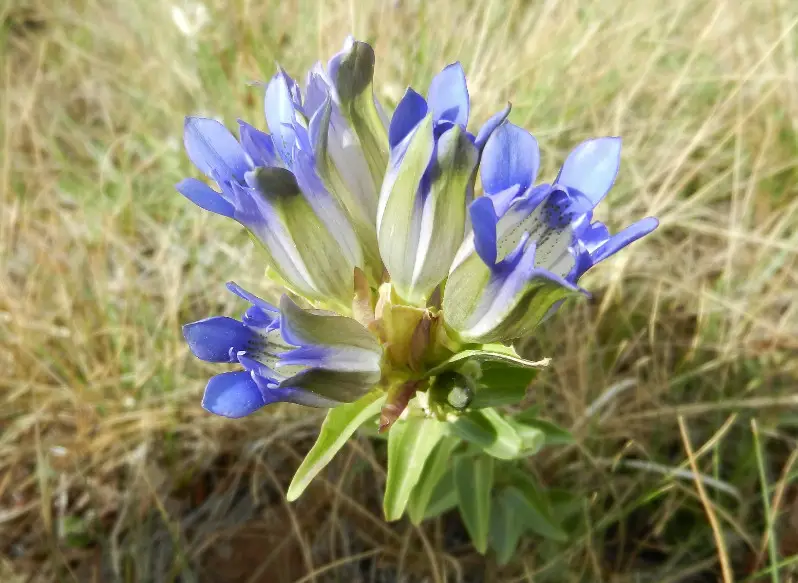
With the exception of California and Nevada, Parry’s gentian (Gentiana parryi) grows best in the Southwestern US states of New Mexico and Utah. Growing to full light, it has tiny blue flowers up to 1.5 inches in diameter along with leaves all the way up the stem. As a real herb, it grows readily in well-drained soils at home.
Forbes’ Glory-Of-The-Snow
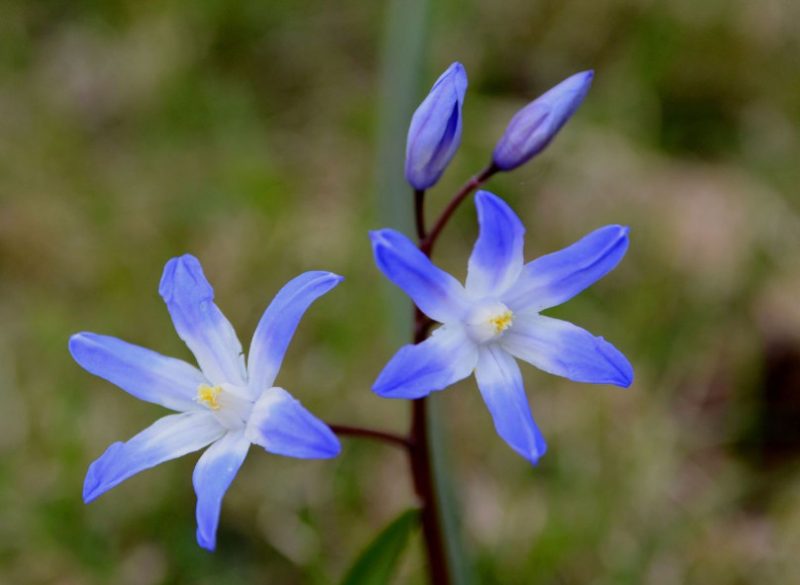
The Forbes’ Glory-of-the-Snow (Scilla forbesii) is an imported wildflower in North America, characterized by a short spring flowering season. Spending almost 11 months in dormancy, it can spread rapidly, reaching a height of up to 5 inches. With green leaves growing from the base of the stem, it’s suitable for planting in containers or outdoor gardens.
Mountain Blue Penstemon
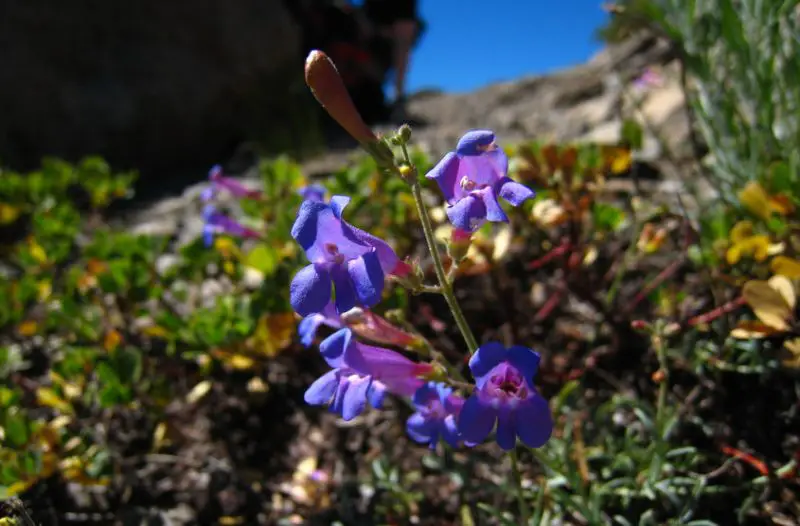
California’s mountains are home to the endangered Mountain Blue Penstemon (Penstemon laetus), which can only be found at elevations of 8,000 feet or higher. It is distinguished by its blue to blue-purple flowers and grows to a height of a few feet as a perennial herb. This blue wildflower, which is found south of Sacramento, attracts a lot of species, including moths, butterflies, and caterpillars. Notably, the Common Buckeye Butterfly and the Mountain Beauty Moth use it as a host plant.
Green Alkanet
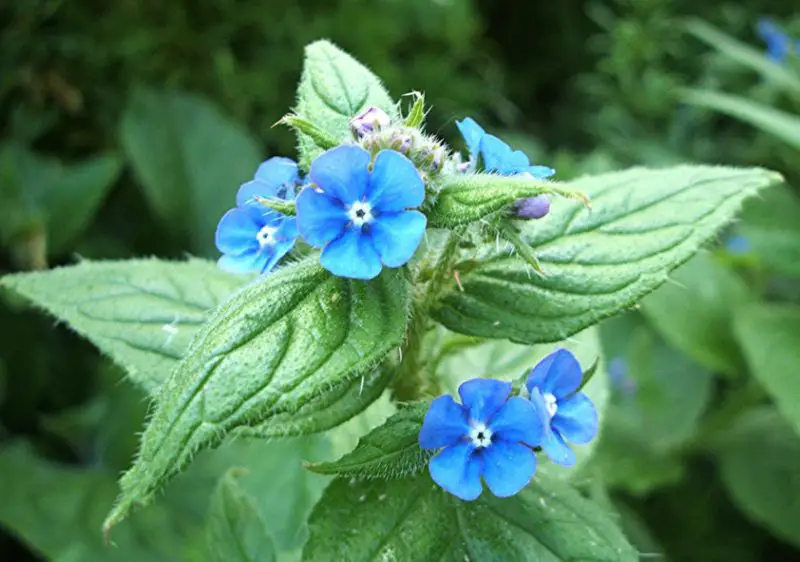
Native to Europe, the Green Alkanet (Pentaglottis sempervirens) is adorned with many blue blooms arranged in little clusters on its stalks. It grows to a height of 24 inches, has leaves like nettles, and is frequently seen in gardens where it thrives in both partial and full shade. The blue blossoms of this wildflower, which are best planted close to walls and structures, have a short life span of a few weeks in late spring or early summer, in contrast to its evergreen leaves that remain green throughout winter.
Hyacinth
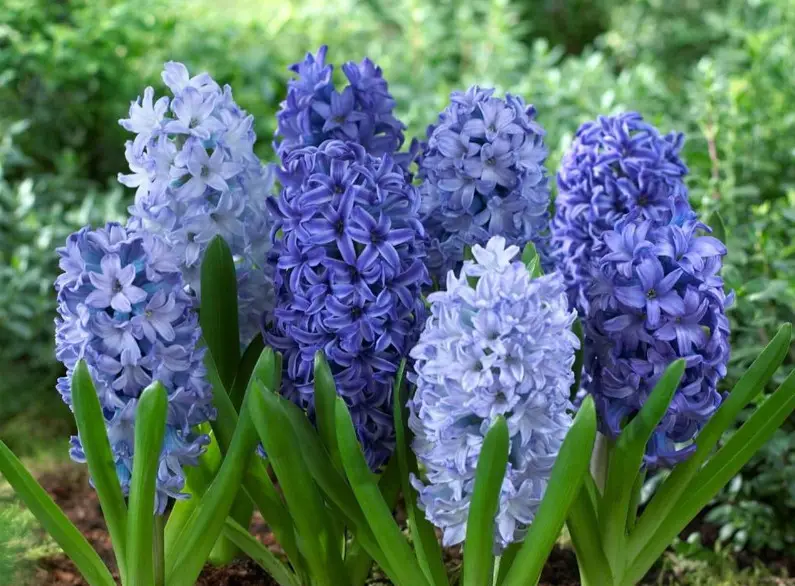
The commonly grown wildflower known as hyacinth (Hyacinthus orientalis) comes in a variety of vivid colors, including blue, pink, yellow, white, and purple. Introduced all over the world, it thrives in gardens and needs wet soil to grow to its full potential. Well known for its pleasant scent, the intensely fragrant blossoms are extracted to create essential oils, which are highly valued components in the perfume industry.
Blue Water-Speedwell
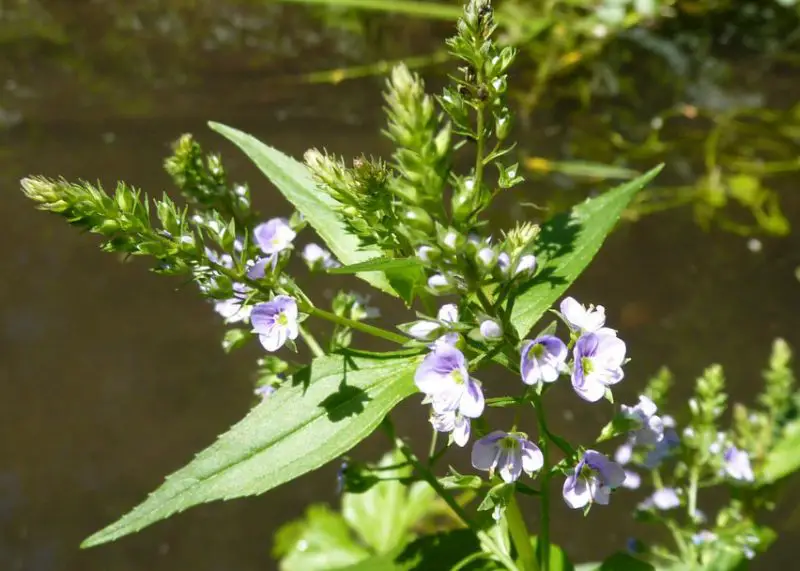
The Blue Water-Speedwell, or Veronica anagallis-aquatica, is a common plant found around the world that grows well next to lakes, ponds, rivers, and riparian zones. Wearing tiny white or blue flowers, it attracts common butterflies, such as those in the Buckeye genus, and is an essential source of pollen for bees.
Water Forget-Me-Not
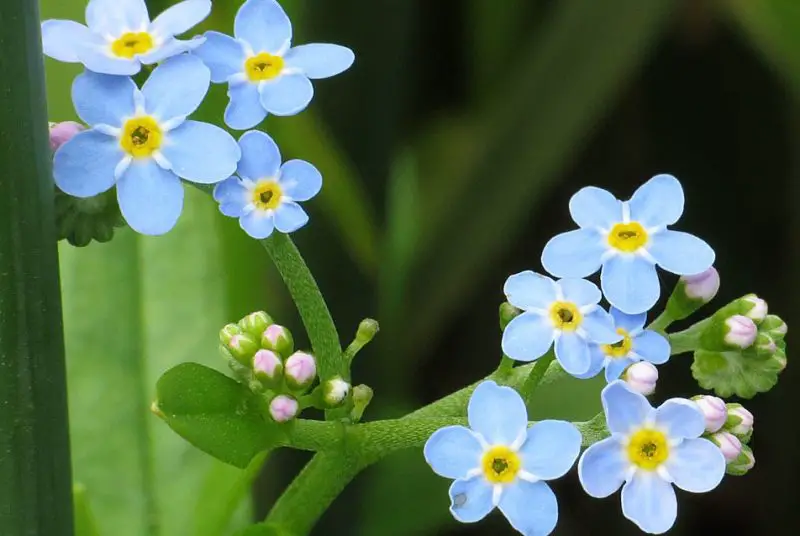
Since its arrival to North America, the Water Forget-Me-Not wildflower (Myosotis scorpioides), which thrives in aquatic settings, has become invasive. It is dangerous because it clogs waterways and pushes aside natural plants. It is abundant both on land and in water. It looks great as a garden pond decoration and is frequently seen around ponds. Its vivid blue colors almost seem white in direct sunlight.
Wild Blue Larkspur
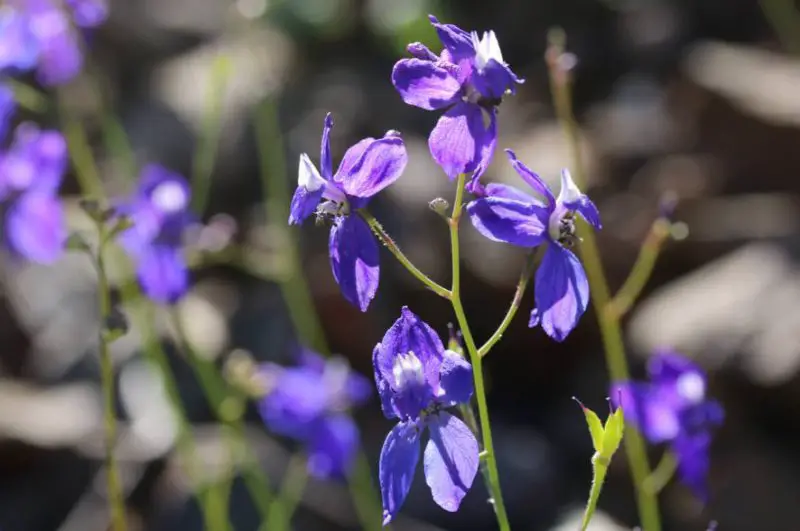
A distinctive characteristic of the Wild Blue Larkspur (Delphinium carolinianum) is the simultaneous blooming of all florets, which results in a profusion of tiny blue flowers. It’s a 3-foot-tall, short-lived perennial that draws a variety of bees, including bumblebees. It can thrive in limestone or sandy terrain and is able to adapt to a variety of arid habitats at varying heights. This plant is native to the Midwestern, Eastern, and Southeastern regions of the United States. It grows well in either full or partial shade.
Bluehead Gilia
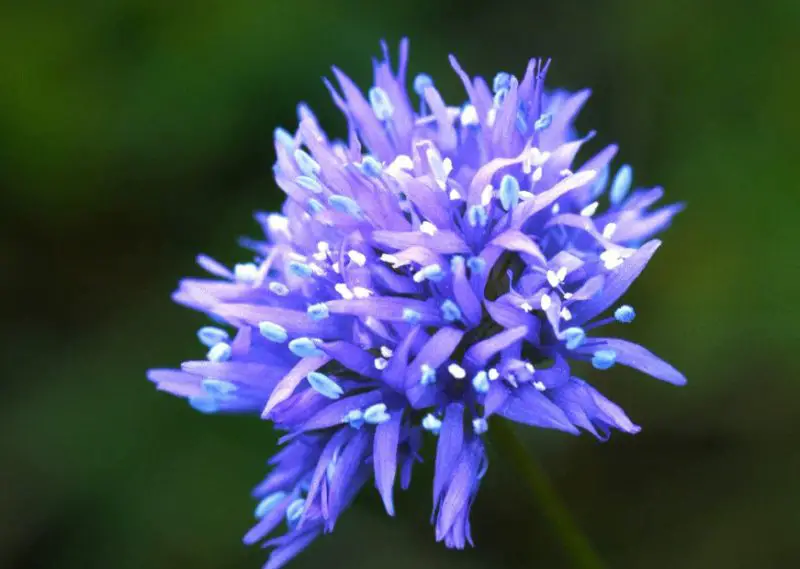
The Bluehead Gilia, or Gilia capitata, is well-known for its eye-catching inflorescences, which can have up to 100 tiny flowers in them. These inflorescences are mostly blue, but they can also have purple, pink, or white tones. The blooms have a broad range that reaches over North and Central America, several Canadian territories, the United States, and the northern regions of Mexico.
Viper’s-Bugloss
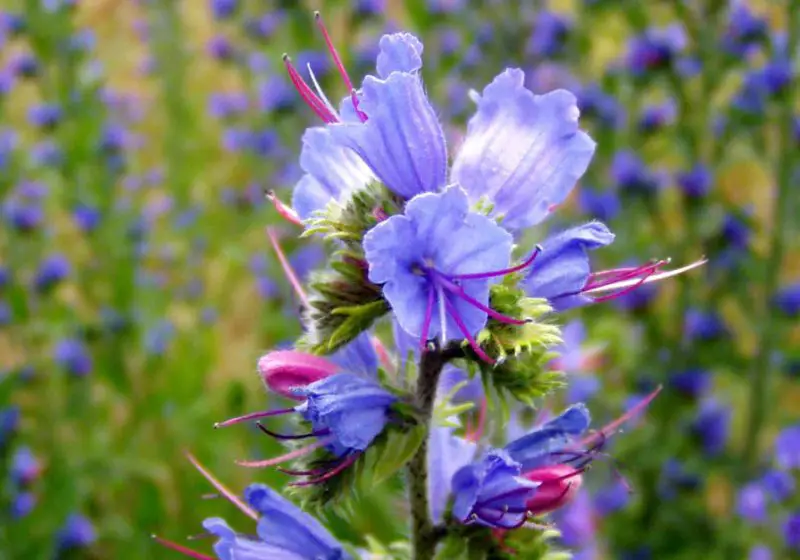
Viper’s-Bugloss (Echium vulgare), an elongated wildflower with multiple blue florets, was introduced to North America, displaying invasive tendencies, though not declared invasive in all states. Not recommended for cultivation at home or on farms with animals due to its high toxicity, which can make cattle ill. With a prolonged flowering period from May to September, caution is advised in areas with animals. Commonly found along roads, coastal areas, lakes, and dunes across the continent.
Desert Bluebells
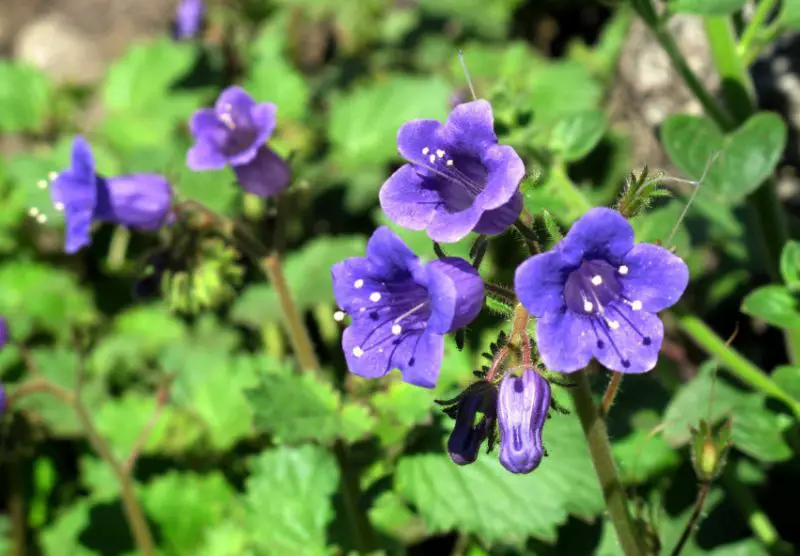
Desert Bluebells (Phacelia campanularia), which are native to the Southeastern United States, may survive with little water in well-drained soils because they are accustomed to dry environments. They display big blue flowers that range in color from pure blue to blue with purple undertones. These blooms can reach a height of several feet and thrive in both native California habitats and deserts. Because their sap irritates skin, it is advisable to handle them carefully at home.
Dwarf Lupine
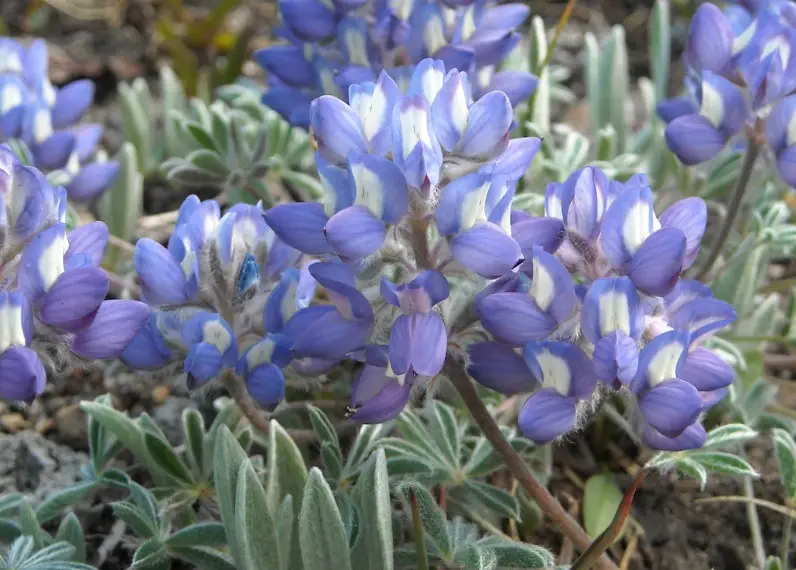
The dwarf lupine, or Lupinus lepidus, is a short plant that is native to North America. Its typical length is a few inches, although it can grow up to 24 inches. Growing best at higher altitudes and especially in full light on mountain slopes, it has flowers of several shades, including familiar ones like lavender and blue. Depending on the flower’s particular habitat, the color may change. This species is widely dispersed, occurring on both the east and west faces of the Rockies, ranging from California to Canada.
Blue Lily
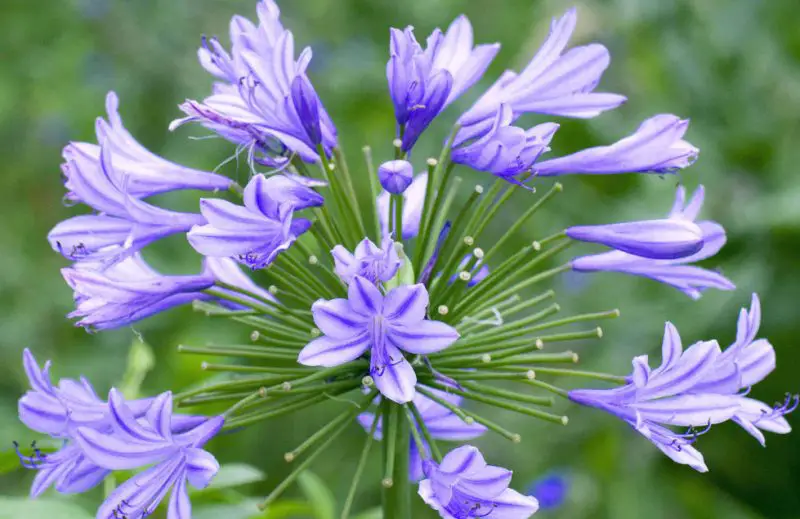
The Blue Lily, or Agapanthus praecox, is native to Europe and Africa and grows best in warm, wet climates. From vivid blue to blue-purple, its inflorescence displays a range of blue tones and appears from spring to summer. The Blue Lily is a great choice for gardens with evergreen foliage because of its elongated leaves, which may grow up to 19 inches in length and at least 1 inch in width. Although it is frequently planted in gardens, because of its strong and perhaps harmful roots, care should be taken when putting it close to residences and walkways.
Spanish Bluebell
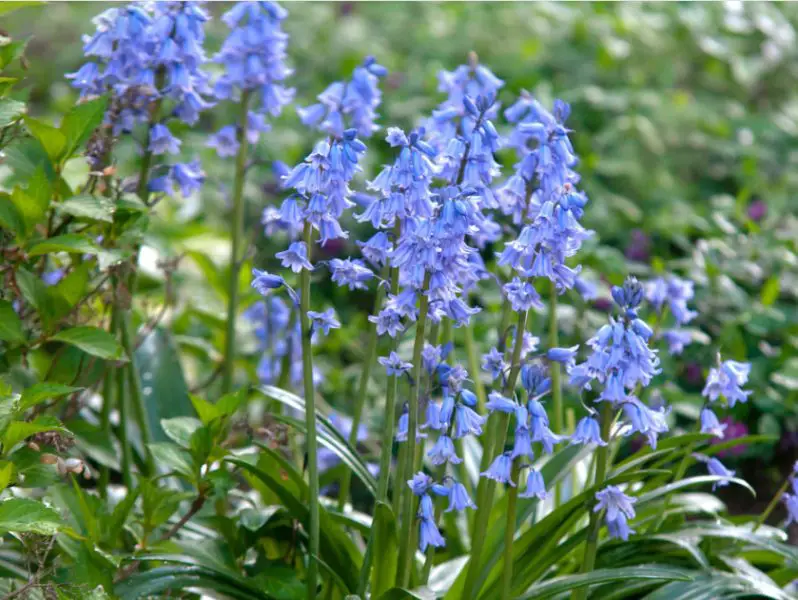
The Spanish Bluebell (Hyacinthoides hispanica) is quite similar to the Common Bluebell, but has bluer, brighter flowers with several florets on each stalk. Its name, which indicates its Spanish origin, is derived from its large leaves, which can reach a length of 10 inches. It is aggressive and invasive, so while it is spread throughout Europe and has made its way to North America via the United Kingdom, growing it in gardens is not advised.
Germander Speedwell
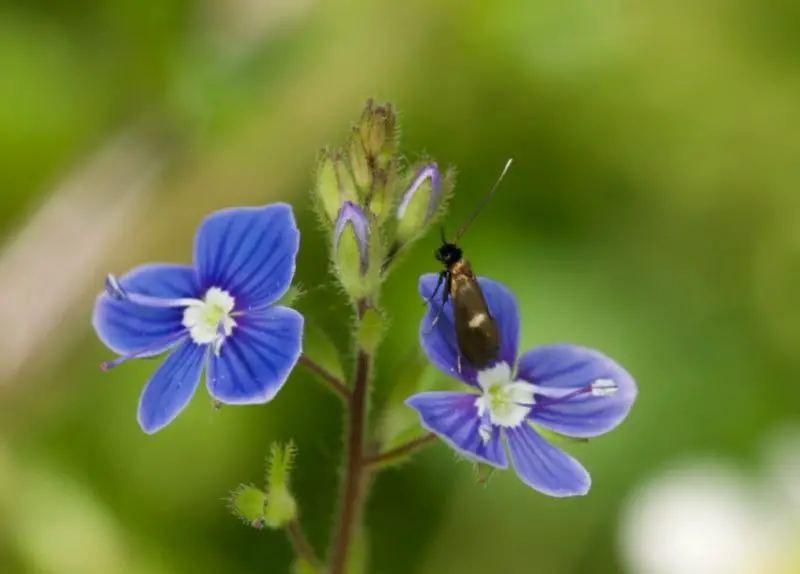
The huge blue-to-purple flowers of the short Germander Speedwell (Veronica chamaedrys) identify it. It is known to be invasive on lawns and is difficult to eradicate because of its wide spreading roots, which cover the grass like a carpet. The little blossoms of this plant, which can typically measure up to 0.5 inches, are difficult to remove by hand. Because boiled roots are thought to improve blood flow and digestion, they are sometimes used in tea.
Roadside Blue-Eyed Grass
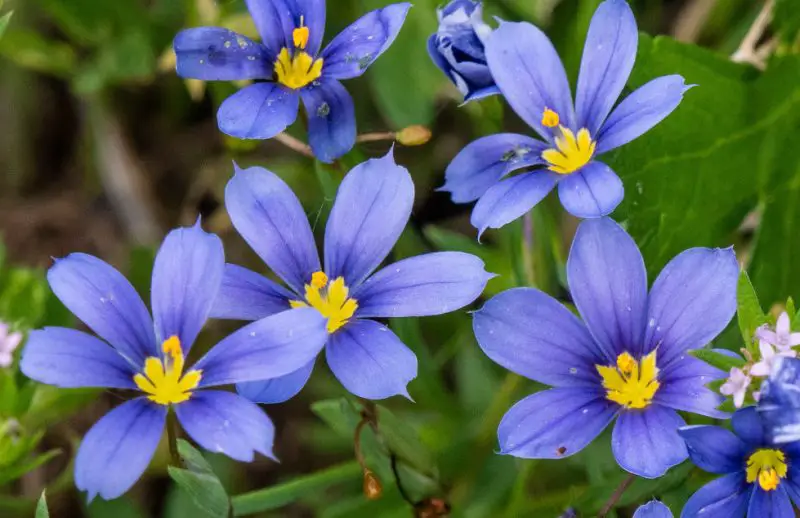
The little flower known as Roadside Blue-Eyed Grass (Sisyrinchium pruinosum) is found all over the United regions, but it is most common in the Southwestern regions. This species spreads quickly and can survive in a variety of conditions, from sea level to a few thousand feet. Growing in wet meadows and grasslands, it has blue petals that sometimes have a pink tinge. The flowers can grow up to 2 inches in diameter, but they don’t last long.
False Dayflower
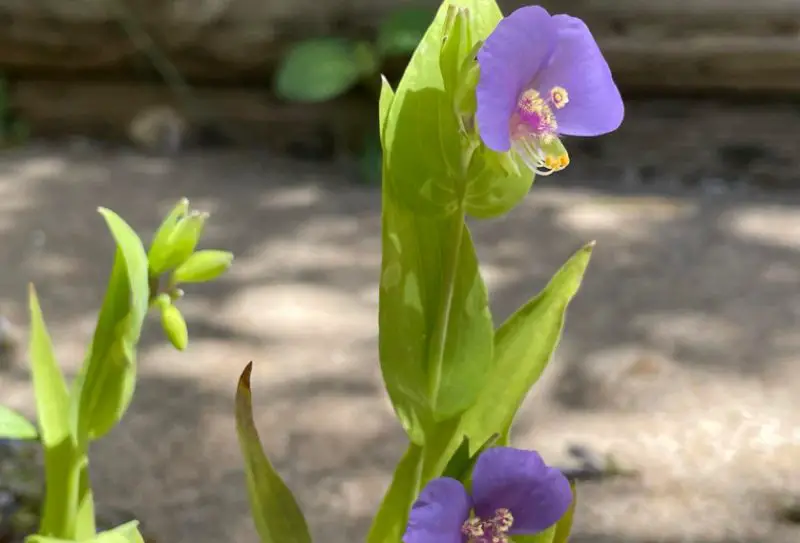
Only found in Texas and a tiny area of northern Mexico, False Dayflowers (Tinantia anomala) are among the rarest blue flowers in North America. The wildflower has enormous blue flowers with a pink base, and it has two different kinds of dark green leaves: some with petioles and some without. It is an important source of food for butterflies and bees, and it helps sustain local pollinators.
Zigzag Larkspur
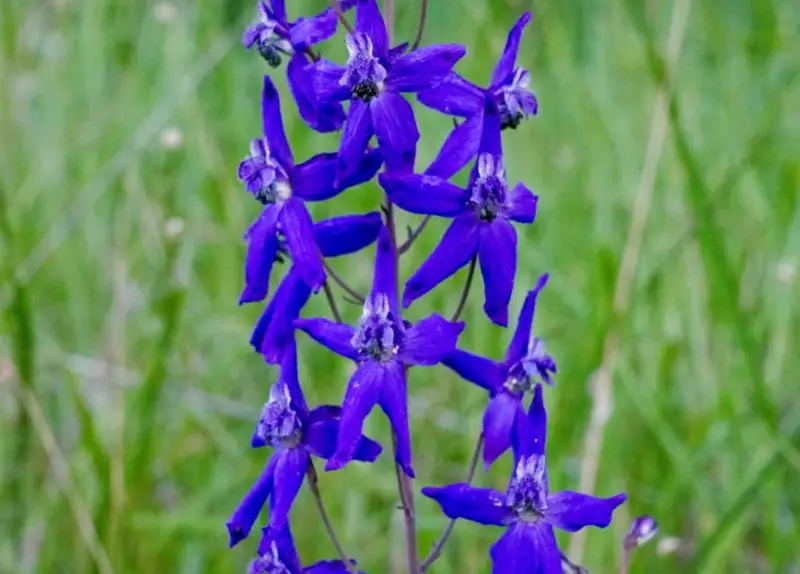
The uncommon blue Zigzag Larkspur (Delphinium patens) flower is unique to California, especially in the coastal regions and the southernmost regions of the state. It reaches a height of 10 to 18 inches and has several bright blue blossoms on its stalks. The flowers, which resemble a particular kind of grass, are fleeting, but the strong, green stems are visible all year round. Notably, the leaves and stems are hairless.
Tall Bluebell
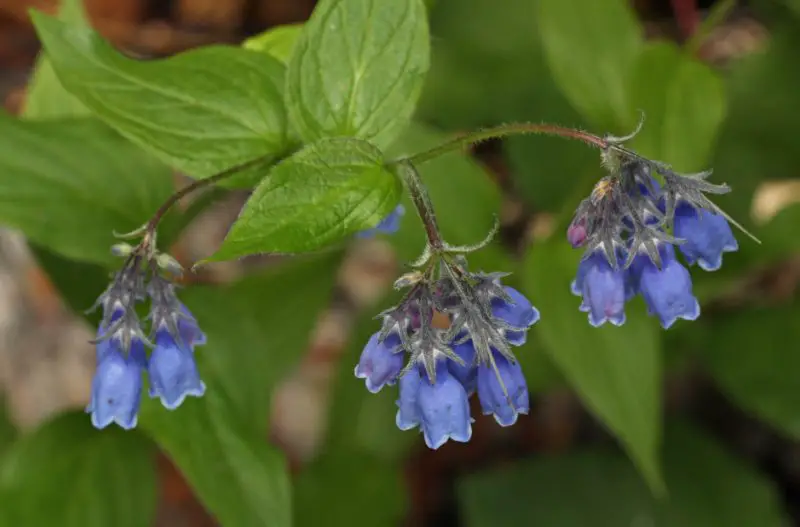
The Tall Bluebells (Mertensia paniculata) are a common plant that can be found throughout North America, even reaching Alaska. With clusters of tiny blue bell-shaped blossoms, these vivid blooms with a hint of dark blue. Tall Bluebells are plentiful yet elusive; they are found mostly at high elevations between forests or in the transitional areas between deciduous and pine woodlands. They contribute to the alpine pastures by being able to acclimate to somewhat lower elevations.
False Forget-Me-Not
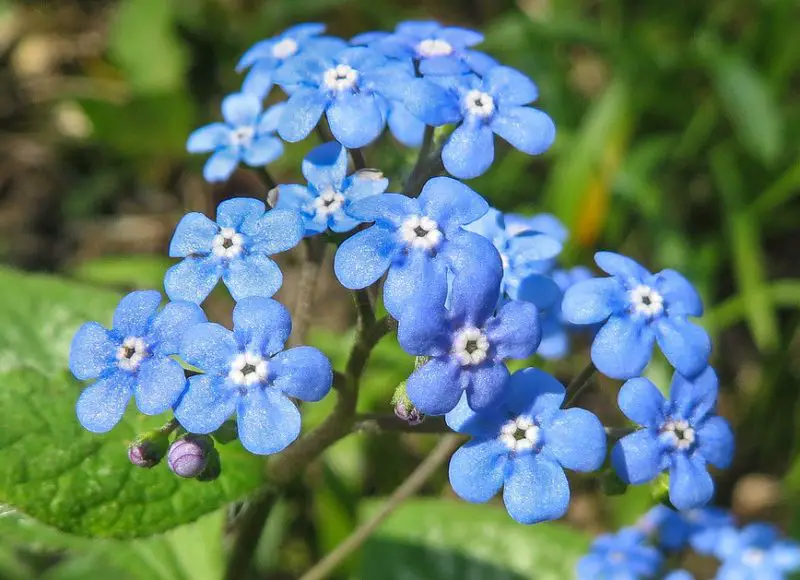
The False Forget-Me-Not is a flexible plant that can take on various shapes due to its ability to grow in a globular shape when clipped. It has little clusters of blue blooms and wide, green leaves that resemble shrubs. Despite its popularity as an ornamental plant, careful pruning is necessary because the plant spreads quickly and may eventually overwhelm nearby plants.
Blue Potatobush

The Blue Potatobush (Lycianthes rantonnetii), a native of South America, has been classified under several names over the years. It was wrongly believed to be edible, despite being a distant related of potato plants, and any portion of it can be poisonous. It’s a member of the Solanaceae family and grows to a good height. It has huge blue or purple flowers that cover several stems.
Garden Grape-Hyacinth
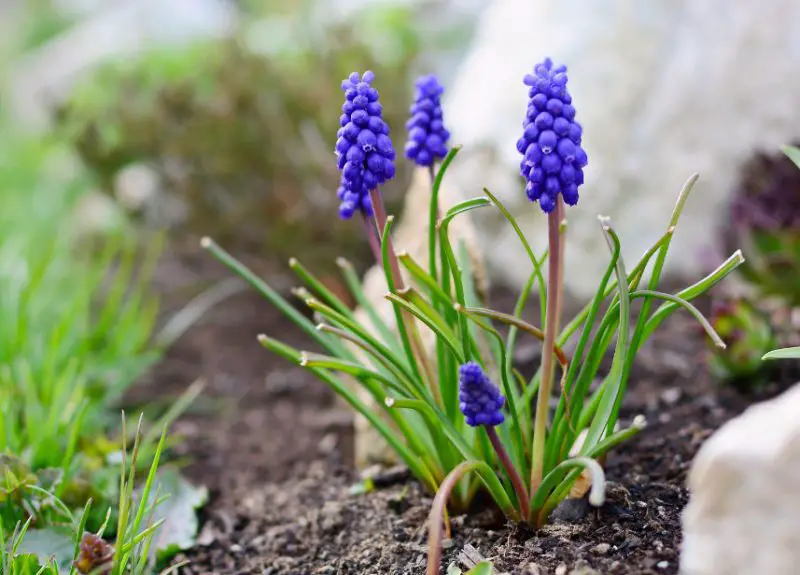
The Garden Grape-Hyacinth (Muscari armeniacum), sometimes referred to as the Grape Hyacinth, is distinguished by long blooming stems that hold inverted cone-like clusters of miniature blue blooms with purple or pink undertones. There are both non-fragrant and fragrant variants of this shrub, and they bloom for two to four weeks. Leaves remain until later fall, although flower visibility lasts until May.
Love-In-A-Mist
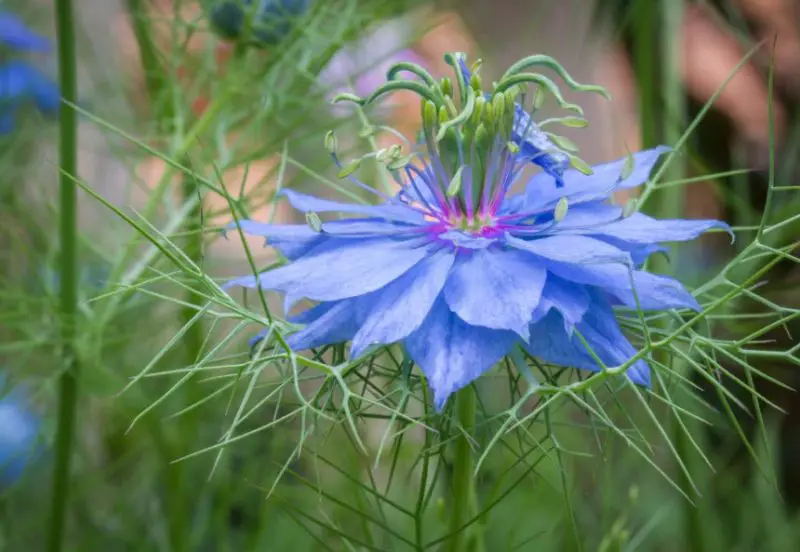
The five huge blue petals of Love-in-a-Mist (Nigella damascena), which are also available in cream, yellow, and white, are what distinguish this flower. This low-maintenance species is easy to grow from black seeds and does well in gardens that receive little rainfall. The numerous blossoms, which have an average diameter of one inch, can be chopped for arrangements and used as floral decorations.

